The Validity and Practicality of the Integrated Learning Model: Physics, Digital, and Local Wisdom
DOI:
https://doi.org/10.18502/kss.v7i19.12489Abstract
Local wisdom is created through the process of integrating humans with nature or the environment for a long time, from generation to generation to form a value system (customs, beliefs, and culture). Local wisdom can be integrated into physics learning because it studies natural phenomena and all their interactions. Local wisdom will be investigated and digitally represented so as to support understanding concepts for solving physics problems, scientific literacy, and digital literacy. The purpose of this research is to design digital learning that is integrated with local wisdom to improve students’ physics problem-solving skills, scientific literacy, and digital literacy. This study uses a development research design with phases consisting of the preliminary phase, prototype phase, and assessment phase. However, in this paper, the validity and practicality of the developed learning are represented. The results showed that the content validity of the digital learning model which was integrated with local wisdom in very valid criteria, the validity of the construct in the criteria is very valid, and the model developed is in the practical category, in terms of the implementation of learning with good and very good categories, as well as student activities that are relevant in learning have increased. This model is expected to be an alternative model for learning physics according to future needs.
Keywords: Integrated learning, physics, digital learning, local wisdom, validity, practicality
References
Fogarty R. The Mindfull School: How to integrate the cuccicula. Hawker Brownlow: Skylight Publishing; 1993.
Sudarmin S, Febu R, Nuswowati M, Sumarni W. Development of ethnoscience approach in the module theme substance additives to improve the cognitive learning outcome and student’s entrepreneurship. Journal of Physics: Conference Series. 2017;824:012024.
Dziuban C, Graham CR, Moskal PD, Norberg A, Sicilia N. Blended learning: The new normal and emerging technologies. International Journal of Educational Technology in Higher Education. 2018;15:1–16.
Graham CR. Emerging practice and research in blended learning: Handbook of distance education. New York: Routledge; 2013.
Arends RI. Learning to teach. 9th ed. New York, USA: McGraw-Hill; 2012.
Plomp T, Nieveen N. Educational design research-part B: Illustrative cases (v – xx) Enschede. The Netherlands: SLO; 2013. Plomp T, Nieveen, editors. Introduction to the collection of illustrative cases of educational design research.
Siswanto J, Susantini E, Jatmiko B. Kepraktisan model pembelajaran Investigation Based Multiple Representation (IBMR) dalam pembelajaran Fisika. Jurnal Penelitian Pembelajaran Fisika. 2016;7:39–43.
Siswanto J, Susantini E, Jatmiko B. Practicality and effectiveness of the IBMR teaching model to improve physics problem solving skills. Journal of Baltic Science Education. 2018;17:381–394.
Plomp T. Educational design research an introduction. The East China: Normal University; 2007.
Moreno R. Educational psychology. New York, USA: John Wiley & Sons Inc.; 2010.
Kurnaz MA, ArslanAG. Effectiveness of multiple representations for learning energy concepts: Case of Turkey. Procedia-Social and Behavioral Sciences. 2014;116:627– 632.
Wiseman DG, Hunt GH. Best practice in motivation and management in the classroom. 3rd ed. Springfield: Charles C. Thomas Publisher; 2013.
Slavin ER. Educational psychology: Theory and practice. Boston: Pearson; 2011.

